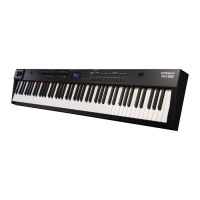14
Performance
Transposing the Key of the Keyboard
(TRANSPOSE)
You can transpose performances without changing the keys you are
playing, as well as change the pitch by an octave. This feature is called
“Transpose.”
This is a convenient feature to use when you want to match the pitch
of the keyboard performance to a vocalist’s pitch, or perform using
the printed music for trumpets or other transposed instruments.
You can adjust the transpose setting in semitone steps over a range
of -5–0–+6 relative to C4. The Transpose has been set at the factory
to “0.”
1 2 3
1. Hold down the [TRANSPOSE] button for several
seconds.
The Transpose screen appears, and the current value of the setting
is displayed.
2. Hold down the [TRANSPOSE] button and press a
key.
If you press the C4 (middle C) key, the transpose amount will be
set to “0.”
For example, to have “E” sound when you play “C” on the
keyboard, hold down the [TRANSPOSE] button and press the E4
key. The degree of transposition then becomes “+4.”
When you release the [TRANSPOSE] button, the previous display
will reappear.
When the amount of transposition is set, the Transpose function
switches on, and the [TRANSPOSE] button lights up.
MEMO
5 You can also transpose by holding down the [TRANSPOSE] button
and using the [DEC] [INC] buttons.
5 If you hold down the [TRANSPOSE] button and press F#4 or a
higher key, the transpose amount is set to [+6].
5 If you hold down the [TRANSPOSE] button and press G3 or a lower
key, the transpose amount is set to [-5].
3. To turn o Transpose, press the [TRANSPOSE]
button so that its indicator goes o.
The next time [TRANSPOSE] button is pressed, the sound is
transposed by an amount corresponding to the value set here.
MEMO
You can set the degree of transposition for each of the Zone
individually. For details, refer to “Making Detailed Settings for Tones”
(p. 22).
NOTE
5 If the transpose amount is 0, the [TRANSPOSE] button will not turn
on even if you press it.
5 When you turn the power o, the transpose amount returns to 0.
Adding Reverberation to the Sound
(REVERB)
The RD-88 can apply a reverb eect to the notes you play on the
keyboard.
Applying reverb adds pleasing reverberation to what you play, so it
sounds almost as if you were playing in a concert hall.
1
1. Turn the [REVERB] knob.
The depth of the reverb eect changes.
You can adjust the reverb depth in a range of 0–127.
MEMO
You can select the type of reverb in the MENU screen 0 “SYSTEM
EFFECTS” 0 “Sys Reverb” page.
NOTE
In the [MENU] 0 [SCENE EDIT] 0 [ZONE EDIT] 0 “INTERNAL”
page, if the “Rev Send (reverb send)” value is set to “0,” no reverb
eect is applied. Also, depending on the settings of the Scene, there
might be cases in which turning the knob does not apply an eect.
For details, refer to “Making Detailed Settings for Tones” (p. 22).

